The Musicarta Canon Project
Transposing the Canon Chord Sequence
- Module Two -
This is the Module Two of the Musicarta Canon Project four-part Transposing mini-series.
To get the most out of this Module, you need to have completed Module One, and have worked through the Canon Project series at least as far as Module Seven.
The Part One F major Canon version
This is the Canon-in-F version we will be developing in this module. The development uses techniques from the main Canon Project series to help you develop your transposing skills.
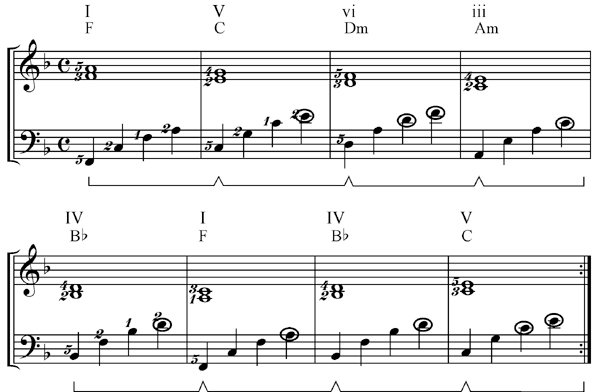
The circled notes are the ‘clashes’ noted at the end of the last module. We are going to use this difficulty to develop the Canon F major version.
Developing the F major Canon version
In the Canon Project Module Two, we used next-door notes to develop the top line of thirds in the treble. In the Canon Project Module Two, we used next-door notes to develop’ the top line of thirds in the treble.
An developed top line of the thirds in F might look like this.
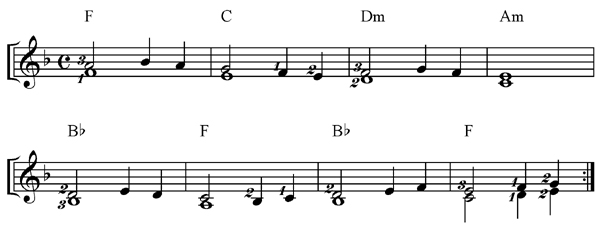
Play this version with two hands, fingered as shown. Get the left hand ‘out of the way’ of the right hand as necessary.
If we made both voices (notes) of the thirds move the same as the top note, we would have this:
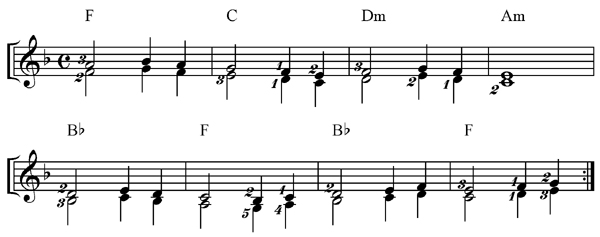
Thirds moving ‘in parallel’ like this always sound nice. The hands are playing really close together – get used to the feeling of them brushing against each other. You’ll probably have to practice the hands separately to get the fingering.
Now think about putting this string of parallel thirds together with the left hand solo accompaniment in F. Don’t try to play the music just yet.
The clashing notes are circled. The audio performance shows what the written music would sound like with the clashes left in place.
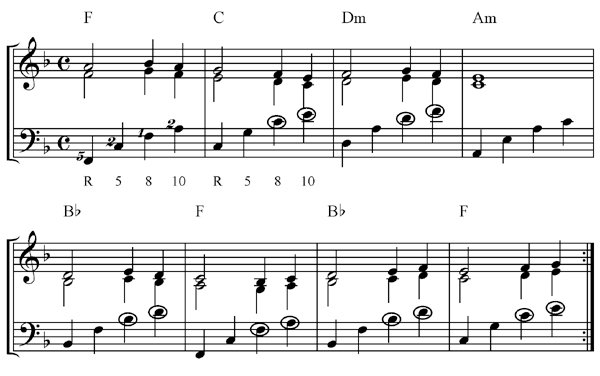
We can cure this ‘clashing’ and make a nice version by playing some of the lower notes of the thirds with the left hand. Instead of playing the clashing accompaniment notes, the left hand will play the lower note of the thirds. (In the first bar, two notes are moved down an octave to make them playable.)
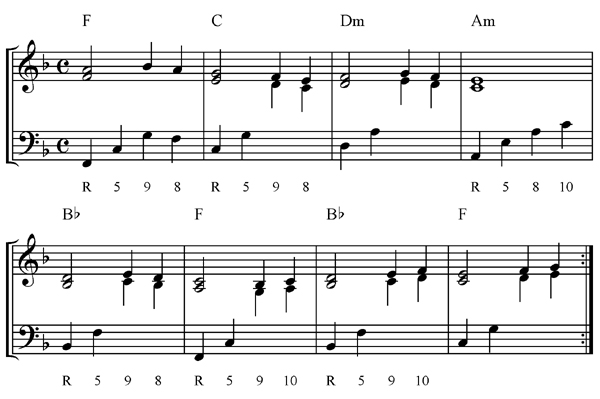
This involves abandoning our repeated left hand ‘R 5 8 10’ formula and using a new chord tone ‘9’ in the left hand. (Pattern accompaniments often have to be adjusted like this.) ‘Nine’ is often found as an added chord tone – you will see ‘add 9’ in chord symbols in popular music. The ‘9’ either goes down to ‘8’ or up to ‘10’ – see the chord tone coding (R, 5, 8, 9, 10) below the music.
Play the variation using the music and the audio and MIDI performance files.
Making variations
This Canon module is an exercise in making the most of something – in this case, the clashing of the right hand thirds and the left hand accompaniment. Once you have mastered the principle – playing the lower voice of the thirds with your left hand - you can easily make a variation.
Look at the right hand of the variation you have just learned. The arrows show which way the treble part ‘sets off’ from the right hand thirds at the start of the bar.
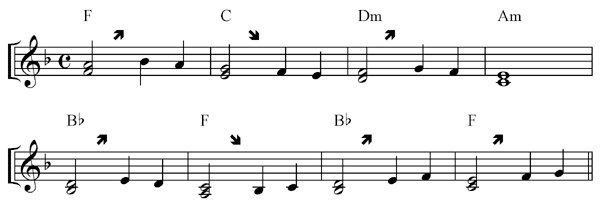
Now look at this version.
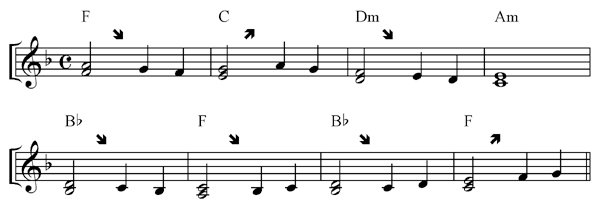
- Errata: In bar 6, the top notes should read C, D, C -
In almost every case, the treble part sets off in the opposite direction to the first version.
Your task is to adapt the left hand accompaniment pattern to this new right hand part. Listen to the audio performance file and try to play it by providing the lower note of the thirds with the left hand (where the right hand doesn’t play them). Start on the ‘upper F’. Use a C sharp in the D minor bar. Listen carefully to the A minor bar in the audio and MIDI performances, where you will hear a B natural ‘9’ used.
The improviser or composer is always making little decisions like this – whether to ‘go up’ or ‘go down’, and how to ‘keep the pattern going’ at the same time. Mechanically working through the possibilities will give you the technique and confidence to make those decisions yourself, eventually in ‘real time’, and play or compose free arrangements on all sorts of different chord sequences.
This is the end of Module Two of the Musicarta Canon Project four-part 'Transposing' mini-series. Module Three goes on to transpose the Canon chord sequence into G and develop a two-handed accompaniment riff. Click through here to continue studying.
Thanks for visiting Musicarta.com! Come again soon!
|
OUT NOW! |
THE MUSICARTA BEAT & RHYTHM WORKBOOK At last! An effective approach to keyboard rhythm & syncopation skills. Learn more! |
ONLY $24.95! |
THE MUSICARTA
|
The MusicartaA methodical approach to keyboard syncopation for
|
PUBLICATIONS
exciting keyboard
creativity courses
CHORDS 101
WORKBOOK

~HANON~
video course

Musicarta
Patreon
PENTATONICS
WORKBOOK
video course

Creative Keyboard
video course

BEAT AND RHYTHM
WORKBOOK

- Volume 1 -

12-BAR PIANO
STYLES WORKBOOK

MUSICARTA MODES
WORKBOOK

PIANO STYLE

CANON PROJECT
video course

VARIATIONS
video course


- Piano Solo -
video course

- Piano Solo -


YouTube playlists


